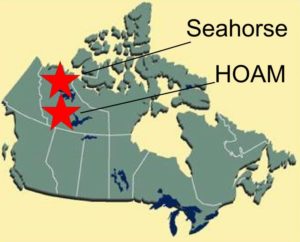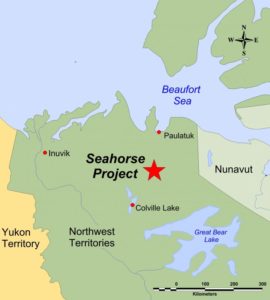Seahorse Project, NWT, Canada

In July 2018, the Company signed an option agreement (the “Option Agreement”) with Talmora Diamond Inc. (“Talmora”) to earn 50% in Talmora’s Seahorse Project, located in the Northwest Territories, by spending $1,200,000 (in a combination of cash and in-kind expenses) over two years on exploration expenditures and making a $200,000 payment to Talmora (the “Option Payment”). The Company has exercised its option to earn 50% of the Seahorse Project in accordance with the terms of the Option Agreement. Olivut and Talmora are joint (50/50) owners of the assets. Talmora retains a 1% NSR on certain land.
The Company considers the Seahorse Project to have the potential to host diamondiferous kimberlite bodies of significant size and perhaps other mineral deposits, based on a combination of: 2019 program results as described below; favourable diamond stability indicator minerals found regionally and locally, including 18 macro diamonds found down-ice in regional samples to the west and northwest; specific geophysical targets; regional and local faults that would favour kimberlite emplacement; occurrence of diamondiferous kimberlites to the north and southeast, as well as other geochemical data in the area.
Olivut successfully completed a helimag geophysical program during April and May 2019. Detailed, low-level, 50 metre line spacing magnetic information was collected and analyzed over multiple anomalies previously identified from regional geophysics.
 During August and September 2019 six holes were drilled to test certain regional geophysical targets that had been confirmed and further delineated by the detailed helimag program. The holes were drilled to a maximum depth of 316’ (96.3 metres) using a reverse circulation, heli-portable drill.
During August and September 2019 six holes were drilled to test certain regional geophysical targets that had been confirmed and further delineated by the detailed helimag program. The holes were drilled to a maximum depth of 316’ (96.3 metres) using a reverse circulation, heli-portable drill.
Beneath tills, each of the holes intersected varying depths of a distinct homogeneous, extremely fine-grained clay that did not appear to be derived from the dolomite country rock that is exposed proximal to the targets. Down hole drilling conditions were exceptionally challenging, as was the recovery of drill sample material, due primarily to the nature of these intersected clays. Samples were collected from each of the holes and sent for analysis to Saskatchewan Research Council (“SRC”).
Preliminary visual inspection, as well as further microscopic examination of many of the collected samples, could not specifically identify the host rock from which the clay material is derived. Subsequently, whole rock and multi-element geochemical results returned complex chemistry characterized by elevated rare earth element (“REE”) content. Further analysis is ongoing to relate these findings to till samples taken down-ice in the general region. These REE levels are generally higher than, or consistent with, levels of REE detected in clays found to occur over some identified kimberlites in some locations of the world (e.g. western Australia and Namibia). Sulphides, including pyrite, galena and sphalerite, as well as other mafic minerals were easily identified in many downhole samples.
The Seahorse Project area underwent periods of extreme warming and laterization that destroyed silicate indicator minerals as evidenced from regional till sampling results. However, some opaque oxide indicator minerals and diamonds survive this type of weathering.
To determine the potential presence of any kimberlitic indicator mineral (“KIM”), additional samples from five drill holes, each consisting mostly of the homogeneous clay, were submitted for heavy mineral analysis to SRC. Chromites, ilmenites (some manganese bearing) and abundant pseudorutile (an alteration product of ilmenite which is common in intensely weathered kimberlite) are present. Although the chromites and ilmenites are not unequivocally kimberlitic, a few definite KIMs (G-9 pyropes and picroilmenites) were recovered from beach sand concentrates taken from a lake in the vicinity of the drill holes.
A surprising result of the heavy mineral analysis is the number of microfossils and the abundance of various forms of pyrite (some replacing organic material and microfossils) found in the concentrates. Also present are spherules (tiny bead-like features) believed to be associated with a meteorite impact. Microfossils and pyrite associated with anoxic (low oxygen) conditions require a different explanation for the origin of the clay than intensely altered kimberlite. Given the results to date, there are a number of possible scenarios that could explain the genesis of these clays and further work is required to obtain more information before arriving at a conclusion.
In addition to the drilling program described above, limited regional prospecting was conducted. A large gossan zone was identified on the property comprising the Seahorse Project that appears to have a strike length of approximately eight kilometres. Very limited sampling was conducted due to budget and fuel constraints. Some of these samples returned trace amounts of gold which may be significant given the limited number of samples collected. Further work is required to obtain more information before arriving at a conclusion. The linear gossan zone occurs within the dolomite country rock and likely represents a sulphide bearing fault zone. The Company’s interest in the Seahorse Project includes any mineral deposits discovered, whether diamonds or other minerals.
This region has been subjected to no known previous detailed exploration work. The Company will report further details once they are available. Due to its remoteness, the project area must be supplied by small aircraft and helicopter. Although Talmora has been active in the area of the Seahorse Project, prior to Olivut’s involvement it had not been able to conduct meaningful exploration due to a lack of financing during the prolonged negative capital market environment for junior exploration companies.
